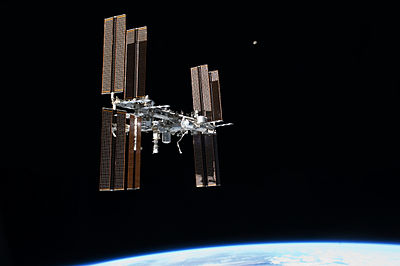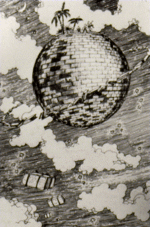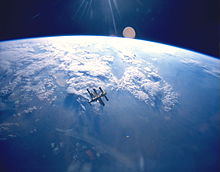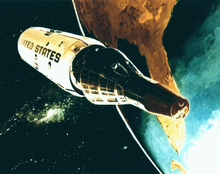
Space station
Did you know...
SOS Children, an education charity, organised this selection. See http://www.soschildren.org/sponsor-a-child to find out about child sponsorship.

A space station (or orbital station) is a spacecraft capable of supporting a crew which is designed to remain in space (most commonly in low Earth orbit) for an extended period of time, and to which other spacecraft can dock. A space station is distinguished from other spacecraft used for human spaceflight by lack of major propulsion or landing systems. Instead other vehicles transport people and cargo to and from the station. As of November 2012 two space stations are in orbit: the International Space Station, and China's Tiangong 1 (which successfully launched on September 29, 2011, after failing in its prior August launch attempt). Previous stations include the Almaz and Salyut series, Skylab and most recently Mir.
Space stations are used to study the effects of long-term space flight on the human body as well as to provide platforms for greater number and length of scientific studies than available on other space vehicles. All space stations have been designed with the intention of rotating multiple crews, with each crew member staying aboard the station for weeks or months, but rarely more than a year. Since the ill-fated flight of Soyuz 11 to Salyut 1, all manned spaceflight duration records have been set aboard space stations. The duration record for a single spaceflight is 437.7 days, set by Valeriy Polyakov aboard Mir from 1994 to 1995. As of 2011, three astronauts have completed single missions of over a year, all aboard Mir.
Space stations have been used for both military and civilian purposes. The last military-use space station was Salyut 5, which was used by the Almaz program of the Soviet Union in 1976 and 1977.
History
Early concepts
Space stations have been envisaged since at least 1869 when Everett Hale wrote about a 'brick moon' in Atlantic monthly magazine. Space stations were also later envisaged by Konstantin Tsiolkovsky and Hermann Oberth.
In 1929 Herman Potočnik's The Problem of Space Travel was published, and remained popular for over 30 years. In 1951, in Collier's weekly, Wernher von Braun published his design for a wheel-shaped space station.
During the Second World War German scientists researched an orbital weapon that could utilize the sun's energy. This so-called " sun gun" would be part of a space station orbiting Earth at a height of 5,100 miles (8,200 km).
With the Apollo 11 landing on the Moon in July 1969, the United States won the race to the Moon over the world's other superpower of the era, the Soviet Union. This caused the Soviet Union to seek other ways to display their spaceflight capabilities.
Salyut, Almaz, and Skylab (1971–1986)
The first space station was Salyut 1, which was launched by the Soviet Union on April 19, 1971. Like all the early space stations, it was "monolithic", intended to be constructed and launched in one piece, and then manned by a crew later. As such, monolithic stations generally contained all their supplies and experimental equipment when launched, and were considered "expended", and then abandoned, when these were used up.
The earlier Soviet stations were all designated "Salyut", but among these there were two distinct types: civilian and military. The military stations, Salyut 2, Salyut 3, and Salyut 5, were also known as Almaz stations.
The civilian stations Salyut 6 and Salyut 7 were built with two docking ports, which allowed a second crew to visit, bringing a new spacecraft with them; the Soyuz ferry could spend 90 days in space, after which point it needed to be replaced by a fresh Soyuz spacecraft. This allowed for a crew to man the station continually. Skylab was also equipped with two docking ports, like second-generation stations, but the extra port was never utilized. The presence of a second port on the new stations allowed Progress supply vehicles to be docked to the station, meaning that fresh supplies could be brought to aid long-duration missions. This concept was expanded on Salyut 7, which "hard docked" with a TKS tug shortly before it was abandoned; this served as a proof-of-concept for the use of modular space stations. The later Salyuts may reasonably be seen as a transition between the two groups.
Mir (1986–1998)
Unlike previous stations, the Soviet space station Mir had a modular design; a core unit was launched, and additional modules, generally with a specific role, were later added to that. This method allows for greater flexibility in operation, as well as removing the need for a single immensely powerful launch vehicle. Modular stations are also designed from the outset to have their supplies provided by logistical support, which allows for a longer lifetime at the cost of requiring regular support launches.
ISS (1998–present)
The core module of the International Space Station was launched in 1998.
The ISS is divided into two main sections, the Russian orbital segment (ROS), and the United States operational segment (USOS).
USOS modules were brought to the station by the Space Shuttle and manually attached to the ISS by crews during EVAs. Connections are made manually for electrical, data, propulsion and cooling fluids. This results in a single piece which is not designed for disassembly.
The Russian orbital segment's modules are able to launch, fly and dock themselves without human intervention using Proton rockets. Connections are automatically made for power, data and propulsion fluids and gases. The Russian approach allows assembly of space stations orbiting other worlds in preparation for manned missions. The Nauka module of the ISS will be used in the 12th Russian(/Soviet) space station, OPSEK, whose main goal is supporting manned deep space exploration.
Russian Modular or 'next generation' space stations differ from 'Monolithic' single piece stations by allowing reconfiguration of the station to suit changing needs. According to a 2009 report, RKK Energia is considering methods to remove from the station some modules of the Russian Orbital Segment when the end of mission is reached for the ISS and use them as a basis for a new station, known as the Orbital Piloted Assembly and Experiment Complex. None of these modules would have reached the end of their useful lives in 2016 or 2020. The report presents a statement from an unnamed Russian engineer who believes that, based on the experience from Mir, a thirty-year life should be possible, except for micrometeorite damage, because the Russian modules have been built with on-orbit refurbishment in mind.
Tiangong (2011–present)
China's first space station, Tiangong-1 was launched in September 2011. The unmanned Shenzhou 8 then successfully performed an automatic rendezvous and docking in November 2011. The manned Shenzhou 9 then docked with Tiangong-1 in June 2012. The manned Shenzhou 10 is expected to visit in 2013. Two more space stations, Tiangong 2 and Tiangong 3 are expected to be launched in subsequent years, paving the way for the construction of a larger space station around 2020.
Habitability
These stations have various issues that limit their long-term habitability, such as very low recycling rates, relatively high radiation levels and a lack of gravity. Some of these problems cause discomfort and long-term health effects. In the case of solar flares, all current habitats are protected by the Earth's magnetic field, and are below the Van Allen belts.
Future space habitats may attempt to address these issues, and could be intended for long-term occupation. Some designs might even accommodate large numbers of people, essentially "cities in space" where people would make their homes. No such design has yet been constructed, since even for a small station, the current (2010) launch costs are not economically or politically viable.
Possible ways to deal with these costs would be to build a large number of rockets (economies of scale), employ reusable rockets, In Situ Resource Utilisation, or non-rocket spacelaunch methods such as space elevators. For example, in 1975, proposing to seek long-term habitability through artificial gravity and enough mass in space to allow high radiation shielding, the most ambitious historical NASA study, a conceptual 10000-person spacestation, envisioned a future mass driver base launching 600 times its own mass in lunar material cumulatively over years.
Architecture
A space station is a complex system with many interrelated subsystems:
- Structure
- Electrical power
- Thermal control
- Attitude determination and control
- Orbital navigation and propulsion
- Automation and robotics
- Computing and communications
- Environmental and life support
- Crew facilities
- Crew and cargo transportation
List of space stations
The Soviet space stations came in two types, the civilian Durable Orbital Station (DOS), and the military Almaz stations. (dates refer to periods when stations were inhabited by crews)
- Salyut space stations
 (USSR, 1971–1986)
(USSR, 1971–1986) - Salyut 1 (1971, 1 crew and 1 failed docking)
- DOS-2 (1972, launch failure)
- Salyut 2/ Almaz (1973, failed shortly after launch)
- Cosmos 557 (1973, re-entered eleven days after launch)
- Salyut 3/Almaz (1974, 1 crew and 1 failed docking)
- Salyut 4 (1975, 2 crews and 1 planned crew failed to achieve orbit)
- Salyut 5/Almaz (1976–1977, 2 crews and 1 failed docking)
- Salyut 6 (1977–1981, 16 crews (5 long duration, 11 short duration and 1 failed docking)
- Salyut 7 (1982–1986, 10 crews (6 long duration, 4 short duration and 1 failed docking)
- Skylab
 (USA, 1973–1979, 3 crews)
(USA, 1973–1979, 3 crews) - Mir
 /
/ (USSR/Russia, 1986–2000, 28 long duration crews)
(USSR/Russia, 1986–2000, 28 long duration crews) - International Space Station (ISS)
 /
/ /
/ /
/ /
/ (United States, European Space Agency, Japan, Russia, and Canada 2000–ongoing, 30 long duration crews as of April 2012)
(United States, European Space Agency, Japan, Russia, and Canada 2000–ongoing, 30 long duration crews as of April 2012) - Tiangong
 (China, 2011–ongoing)
(China, 2011–ongoing) - Tiangong 1 (2011–ongoing, 1 crew as of June 2012)

Canceled projects
- United States Air Force Manned Orbiting Laboratory project, canceled in 1969 about a year before the first planned test flight; this was unusual in being an explicitly military project, as opposed to the Soviet Almaz program, which was heavily intertwined with, and concealed by, the contemporaneous Salyut program.
- A second Skylab unit ( Skylab B) was manufactured, as a backup article; due to the high costs of providing launch vehicles, and a desire by NASA to cease Saturn and Apollo operations in time to prepare for the Space Shuttle coming into service, it was never flown. The hull can now be seen in the National Air and Space Museum, in Washington DC.
- A number of additional Salyuts were produced, as backups or as flight articles that were later canceled.
- The U.S. Space Station Freedom program, which, despite being under development for ten years, was never launched, instead evolving into the International Space Station
- The Soviet/Russian Mir-2 station, which was never constructed, had some of its elements incorporated into the International Space Station.
- The Industrial Space Facility was a station proposed in the 1980s that was to be privately funded. The project was canceled when the company created to build it, Space Industries Incorporated, was unable to secure funding from the United States government.
- The European Columbus project planned to create a small space station serviced by the Hermes shuttle. It evolved into the ISS Columbus module.
Future developments
- The People's Republic of China is expected to launch two more space labs called Tiangong 2 and Tiangong 3 before 2016. It will then launch a three module 60-ton space station by 2020. Project 921-2 is the working name given by the People's Republic of China for plans to create a manned space station. The public is being asked to submit suggestions for names and symbols to adorn the planned Chinese space station.
- U.S. company Bigelow Aerospace is developing the Bigelow Commercial Space Station, a private orbital complex. Bigelow proposes to construct the space station using both Sundancer and BA 330 expandable spacecraft modules as well as a central docking node, propulsion, solar arrays, and attached crew capsules. Initial launch of space station components is planned for 2014, with portions of the station available for leased use as early as 2015. Bigelow began to publicly refer to the initial configuration—two Sundancer modules and one BA-330 module—of the first Bigelow station as Space Complex Alpha in October 2010. A second orbital station—Space Complex Bravo—is scheduled to begin launches in 2016. As of February 2011, the launches for Space Complex Alpha have been contracted to launch on Atlas V and Falcon 9 launch vehicles, from Cape Canaveral, starting in 2014.
- In April 2008, the Russian space agency proposed the construction of an orbital construction yard (OPSEK) for spacecraft too heavy to launch from Earth directly. It would not begin construction or be finished until after the decommissioning of the International Space Station. This plan was described to ISS partners by Anatoly Perminov June 17, 2009.
- The Orbital Technologies Commercial Space Station is a project of a Russian corporation (Orbital Technologies). The CSS is intended to accommodate diverse functions such as:
- Enabling space-based microgravity research.
- Providing a destination for commercial human spaceflight, space tourism, and state sponsored human spaceflight programs.
- Acting as a backup and emergency safe haven for the International Space Station and its crew.
- Enabling product development.
- Facilitating satellite servicing and maintenance.
- Providing a staging outpost for human space flight missions beyond low Еarth orbit.
- Supplying a uniquely capable remote sensing platform.
The business arrangement for developing and marketing the station was recently clarified by Russian firm Orbital Technologies, who is collaborating to develop the station with the Rocket and Space Technology Corporation Energia (RSC Energia).
- Excalibur Almaz, an international company based in the Isle of Man in the UK and headed by Arthur Dula, is developing a system integrated by a reusable space vehicle and a space station based on the technology of the Soviet military stations "Almaz". In this efforts, Excalibur-Almaz is co-working with a Russian corporation with a large tradition in aerospace technology, the military-industrial association "Mashinostroyenia".
- In December 2011 Boeing proposed using Node 4 as the core of an Exploration Gateway Platform to be constructed at the ISS and relocated via space tug to an Earth-Moon Lagrange point (EML-1 or 2). The purpose of the platform would be to support lunar landing missions with a reusable lunar lander after the first two SLS flights. It would also bypass the need for a L1 propellant depot for lunar missions. Other hardware would include an airlock, an 'international module', and a MPLM based habitat module.
- In February 2012 Playboy proposed an orbital "space club", in conjunction with Virgin Galactic. Their plans include a restaurant and a zero gravity dance club.





